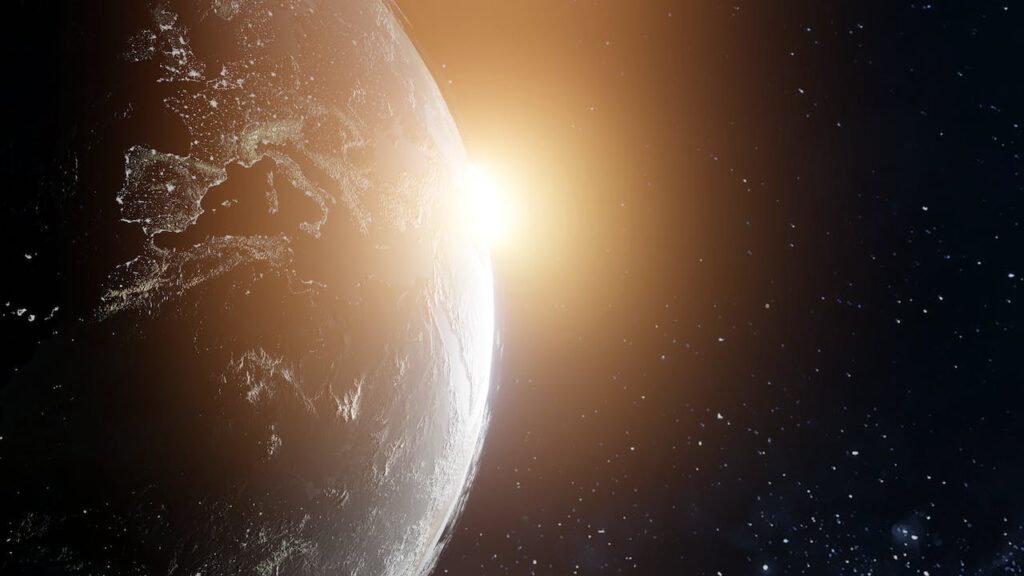
The Sun, our star that brings us light and heat needed for our survival has always been topic of fascination among humans. We see it almost every day (depending, of course where we live on Earth), and we wonder about its hugeness.
However, this cosmic giant is so massive that it defies human comprehension. We see it as a yellowish and small circle in the sky and it’s hard for us to even fathom how large it is.
Having said that, have you ever wondered how many Earths could fit in the sun?
In this article, we will delve into the mathematics of scale and reveal the astonishing answer.
Related: What Would Happen If The Sun Exploded?
Related: How Many Earths Can Fit In Jupiter?
Related: If Our Sun Was The Size Of A Grain Of Sand, Then How Big Would The Milky Way Be?
Calculations – Comparing Earth and Sun

To understand the enormity of the Sun, we need to explore its key characteristics.
The Sun has an approximate diameter of about 1.4 million kilometers and is predominantly composed of hydrogen and helium.
The volume of a celestial body is directly related to its size, so let’s calculate just how many Earths could fit inside the Sun.
Mathematical Calculations:
The volume of a sphere (and both Earth and Sun are (non-perfect) spheres) can be calculated using the formula V = (4/3)πr³, where V represents the volume, π (pi) is approximately 3.14159, and r is the radius of the sphere.
For the Sun, with a radius of around 696,340 kilometers (432,450 miles), the volume would be:
V = (4/3)π(696,340 km)³
This calculation results in a staggering volume of approximately 1.41 x 10^18 cubic kilometers for the Sun.
Formatting this in somehow readable number, that would be 1,409,272,569,059,860,000 cubic kilometers or 338,102,469,632,763,000 cubic miles.
Unimaginable numbers for sure. And actually, there is a word for those huge numbers
In cubic kilometers we would pronounce abovementioned number as follows:
„1.4 quintillion cubic kilometers“
Ok, back to our calculations, we’re not done yet. Now we need to compare Earths volume with the volume of the Sun.
So, the Earth’s diameter is approximately 12,742 kilometers (7963 miles), which means its radius is half of that.
Using the same formula, we can find the volume of the Earth:
V = (4/3)π(12,742 km)³
This yields a volume of approximately 1.08 x 10^12 cubic kilometers for our planet.
Again, trying to format this in readable number for us humans we’d have following:
260 billion cubic miles (1.086 trillion cubic kilometers)
So, to find out how many Earths could fit inside the Sun, we divide the volume of the Sun by the volume of the Earth:
1.41 x 10^18 cubic km (Sun) / 1.08 x 10^12 cubic km (Earth) = 1.31 x 10^6 Earths
Incredible, isn’t it?
Approximately 1.31 million Earths could fit inside the Sun!
As mentioned at the beginning, that’s completely incomprehensible for our minds.
I mean, we are living in this (for us) huge planet where if we could walk all the way around, it would take us several years (5-10 probably depending on the pace).
And yet, compared to Sun the Earth it is still rather small. Tiny actually. Something like a ping pong ball on football stadium.
So yeah, there you have it – more than 1.3 million Earths could fit our star. And this is of course only approximation because Sun and Earth are not perfect spheres.
Actually, Sun is much more perfect sphere than our planet.
Namely, scientists conducted precise measurements of Sun’s dimensions and they concluded that Sun is most perfectly round natural object known in the universe.
So, with that fact let’s look at couple of other interesting facts regarding the Sun & Earth.
Earth & Sun – Interesting facts

- If you lined up 1.31 million Earths, their total length would extend for over 7.5 billion kilometers. That’s enough to circle the Earth over 187,500 times!
- Length of a Day on the Sun: The Sun, being a gaseous object, doesn’t have a solid surface, so it doesn’t rotate like Earth does. However, different parts of the Sun’s surface rotate at varying rates. Near its equator, it takes about 25 Earth days to complete one rotation, while at the poles, it can take over 35 Earth days.
- Length of a Year on the Sun: The Sun doesn’t experience years in the way we do on Earth since it doesn’t orbit around any other celestial body. It’s the center of our solar system, and everything else orbits around it. Our concept of a year is based on Earth’s orbit around the Sun.
- Surface Temperature: The Sun’s surface, known as the photosphere, has an average temperature of around 5,500 degrees Celsius (9,932 degrees Fahrenheit). However, in its core, where nuclear fusion takes place, temperatures can soar to an incredible 15 million degrees Celsius (27 million degrees Fahrenheit).
- Mass of the Sun vs. Mass of All Planets in Our Solar System: The mass of the Sun is truly amazing. It contains 99.86% of the total mass in our solar system. To put it in perspective, the Sun’s mass is about 333,000 times greater than Earth’s mass, and when you add up the mass of all the planets, asteroids, and other objects in our solar system, it’s still just a tiny fraction of the Sun’s immense bulk.



























